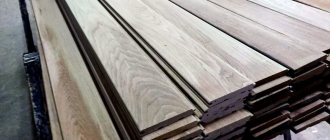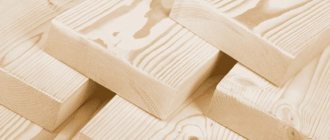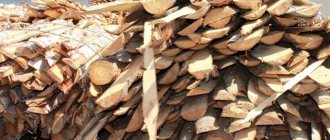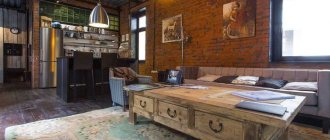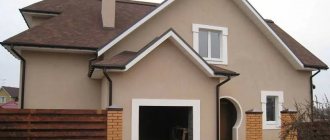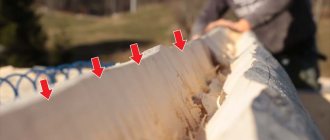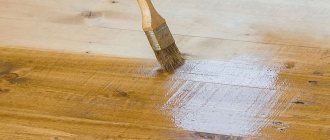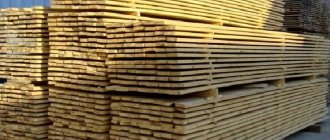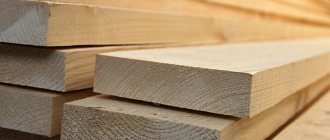General characteristics of the board
The board is highly durable and durable in use. It is worth noting that such material is considered completely safe and environmentally friendly.
According to GOST standards, a board is considered lumber that has a thickness of no more than 10 cm and the width should not exceed 2 times the thickness.
You can make a board in several ways:
- Cut into pieces. In this case, as a rule, the wood is cut with a band saw. From one tree you can get more than 2 unedged boards.
- Sawing with timber. It is also produced using a band saw; the boards can be edged or unedged.
- Made from unedged material. The boards are made using a special apparatus by sawing off the edges and the output is an edged board.
- Sawing with milling. The process occurs due to the milling and sawing apparatus, which allows you to obtain an edged board in one pass.
What is lumber
Lumber refers to wood products that have established dimensions and quality standards. These products are made from primary raw materials - tree trunks (coniferous or deciduous), previously cleared of branches and foliage (“Wood species for building a house”).
Lumber production
Note: Lumber is obtained by longitudinally cutting round logs at sawmills that use special equipment (sawmills).
Types of boards by cut
Depending on how the edges are cut, all boards are divided into several types:
- Edged board is the most popular material for use in construction stages and for finishing work. The edged board has two sides cut straight. The edges of such a board may be parallel or non-parallel, but the wane parameters comply with established standards.
- A single-sided edged board has one edge, which is completely an element of the log, and the second is smooth and well sawn.
- Not an edged board. This material has unsawed or partially sawn edges. As a rule, such material is used for rough work or for outbuildings, fencing and fencing.
Material grades
The quality of materials is determined by grade, which is a cumulative indicator of suitability in accordance with GOST .
Different materials have grades:
- Coniferous wood products (bars and boards) are divided into 5 grades, with grades 1–4 classified as selected;
- beams are divided into 4 grades;
- Products made from deciduous trees are produced in three varieties.
When assigned to a certain class, they take into account compliance with dimensions, parallelism of edges and wide sides, the presence of defects, humidity, roughness and many other indicators.
Define classes using several methods:
- visually with the detection of defects;
- predicting probable strength based on several measured indicators;
- a combination of the first two methods.
Valera
The voice of the construction guru
Ask a Question
Products are assessed by the condition of the surface or side surface, which is recognized as the worst in the product. Bars and beams are certified according to the worst plane, taking into account the presence of impregnation against humidity, microorganisms, and ignition. Non-compliance with one of the indicators classifies the workpiece as a lower grade or transfers it to the category of defective goods.
Chipboards
It is obtained by pressing wood waste under pressure at high temperatures. To glue particles together, polymer resins , the amount of which does not exceed 7–10% of the total volume of the material. Melamine-formaldehyde, carbide, formaldehyde resins, a small amount of water repellents, and antiseptics are used.
according to density :
- low - up to 550 kg/m³;
- average – 550 – 750 kg/m³;
- high - over 750 kg/m³.
For various conditions of use (humidity, exposure to chemicals), 7 types of particle boards are produced, marked from P1 to P7 . They produce slabs with sanded and unpolished surfaces, which can be fine-textured or smooth. solid, hollow, layered and single-layer products ; there are options with additional reinforcement with organic and cellulose fibers.
Based on the formaldehyde content in mg per 100 g of dry panel, emission classes :
- E0 - no more than 5 mg (non-hazardous);
- E1 - 5 - 8 mg (can be installed in housing with restrictions);
- E2 - 8 - 30 mg (only outside residential premises).
The concentration limit of harmful substances in room air is 0.5 mg/m. A person perceives an unpleasant odor already at a concentration of 0.4 mg/m3. The emission class is indicated by the manufacturer in the markings on the product and in the certificate of conformity.
Cutting board for outer plate
Depending on the type of outer side of the board, they are divided into certain types:
- Croaker - boards obtained from trimming the sides of a log. One side of this material is propylene, and the other is propylene, partially or completely in its original form. All parameters comply with the standards.
- A plank slab is, in principle, a slab-type board, but the outer surface is propylene for more than half of the entire length.
- Obapol - boards that are completely sawn on the inside, and the outer faces are only partially sawn or completely in their original form.
- A plank obapol is a board that has a cut in the outer part for more than half the entire length of the board.
- Croaker obapol is a board that has a cut on the outside of less than half the length.
GOSTs regulating the production of lumber
To control the quality of goods produced by a particular industry, the state developed sets of rules called GOSTs.
GOST (State Standard) is a regulatory document that establishes standards and requirements for the production, storage, transportation and release of certain products.
The main tasks of State Standards are aimed at ensuring high quality of goods and uniformity of measurements.
The first State Standard was developed in 1925 - it controlled the cultivation of wheat. Today there are a great many of these regulatory documents; they affect almost all areas of human activity.
During the Soviet era and until September 1, 2011, it was mandatory to comply with GOST standards, but now many manufacturers, in order to save materials or for some other reason, are developing their own documents establishing production standards, the so-called TU - Technical Conditions.
The consumer always has a choice - to buy goods manufactured according to GOST or according to specifications.
When producing lumber, compliance with State standards is an extremely important point, since the strength, reliability, durability and appearance of structures assembled from wood will depend on the quality of lumber products.
Basic GOST standards for lumber
Today, several dozen domestic State Standards regulate production, transportation, storage, distribution and other actions related to various types of lumber and round timber.
Some of these documents are long outdated, since they were adopted back in the days of the planned economy of the last century - they are overloaded with unnecessary information that is not relevant for modern building codes, and may contain contradictory information.
And for some particularly popular modern lumber and wood-based products such as eurolining, block house, tongue and groove flooring, OSB, domestic GOST standards do not exist at all - Russian manufacturers, in their production, rely on foreign standards (for example, DIN), while , how domestic experts are modernizing standards and working on their unification.
If you are planning to build a house made of wood, but are not a professional builder, in order to avoid deception by unscrupulous manufacturers and sellers of lumber products, it would be a good idea to study a dozen current GOST standards that regulate the interaction between a lumber manufacturing enterprise and the buyer. The most relevant and useful for the consumer are the following documents:
- GOST 18288-87 - gives clear definitions of all terms used in sawmilling;
- GOST 2140-81 - describes all wood defects studied to date, found in both sawlogs and finished products;
- GOST 8486-86 – regulates the division into grades of lumber products from pine needles;
- GOST 2695-83 – establishes the dimensions, maximum deviations and grades of hardwood lumber;
- GOST 24454-80 – establishes requirements for the dimensions of softwood lumber and determines permissible deviations from them;
- GOST 3808.1-80 - talks about how to properly store lumber and lay it for atmospheric drying;
- GOST 16588-91 – describes possible methods for determining the moisture content of wooden products;
- GOST 20022.2-80 - provides a classification of wood species according to resistance to decay, as well as a classification of protective agents;
- GOST 20022.6-93 – defines the main methods of applying protective compounds;
- GOST 3916.1-96 - here you can study the basic concepts relating to such a widely popular building material as plywood (dimensions, classification by water resistance and degree of processing, grades...);
- GOST 8242-88 - describes the basic parameters that must be observed in the manufacture of such profiled wood products as floorboards, window sills, skirting boards, and trims.
GOST 18288-87
Sawmill production is a broad branch of industry; it is simply impossible to imagine it without certain standards and definitions.
In order to study the range of lumber available for sale today and understand where it is permissible to use one or another variety, you need to read the State Standard under number 18288-87, which is called “Sawmill production. Terms and Definitions".
This document is still relevant; the requirements it establishes are mandatory for use in any type of documentation related to the description of modern lumber. This GOST explains the basic concepts relating to wooden products produced by radial or tangential sawing.
State standard number 18288-87 is a kind of dictionary that will help the average consumer understand such fundamental issues as, for example, “how a planed board differs from a regular edged board,” “what is a face, an edge, an end, an edge,” “what is a timber different from a block” and the like.
GOST 2140-81
This regulatory document is called “Visible Wood Defects”. Here you can find a classification of defects, descriptions and methods of measuring each of them.
According to GOST 2140-81, visible defects are deficiencies in individual sections of lumber or finished products that reduce quality and limit the ability to use lumber for its intended purpose.
The document describes in detail all wood defects studied to date, dividing them into groups, types and varieties. Here you can read about knots and cracks, various defects in the shape of the trunk and structure of the wood, biological damage and fungal infections.
Mechanical damage to wood and defects resulting from poor-quality processing are also described in detail.
For the average consumer, it is very important to study this regulatory document, since the presence of certain defects on lumber (their number and size) is a fundamental factor for dividing products into grades.
GOST 8486-86
The document regulates the division of lumber products into grades. There are five varieties in total - selected, first, second, third and fourth. For each of them, the maximum permissible presence of a particular defect is indicated (in terms of quantity and size).
The information is presented in the form of tables that are clear and understandable to the average person, using which you can determine what grade of lumber you are buying. Armed with GOST 8486-86, you protect yourself from deception, because some unscrupulous sellers can sell the first grade at the price of the finest, and the like.
GOST 24454-80
The document is called “Softwood lumber. Dimensions". This State Standard is basic, defining standard dimensions and tolerances. Its requirements apply to edged and unedged softwood lumber products.
GOST 24454-80 defines the nominal values of width and thickness, as well as the proportions between these indicators. For the consumer, data on permissible maximum deviations is especially important.
Lumber products with larger or smaller deviations from the dimensions specified in GOST can be produced, but a separate TU document (Technical Conditions) is drawn up for it - such lumber is cheaper, it is unacceptable to sell them under the “GOST” marking, the sale of such products is possible only under the “TU” marking.
GOST 8486-86 and GOST 24454-80 concern lumber from softwood. A separate document has been developed for deciduous lumber products - GOST 2695-83 “Hardwood lumber. Technical conditions". Dimensions and tolerances are regulated here; there is a clear table in which hardwood lumber is divided into three grades, depending on the number and size of defects present.
GOST 3808.1-80
The document is called “Softwood lumber. Atmospheric drying and storage." This State Standard is equally important for both the manufacturer and the consumer.
Having studied the rules for storing lumber in warehouses, the buyer can always evaluate how accurately they are followed by the seller.
This is a very important point, because if wooden products are stored incorrectly, they can lose their technical and consumer characteristics - the wood can be affected by fungus, crack, and the formation of such a defect as warping is also possible.
In addition, GOST 3808.1-80 will teach you how to properly store lumber on a construction site. Here you can read how to choose a suitable location and how to properly stack boards.
Boards from part of wood production
A big role is played by what part of the log the board was made from, so they are divided into groups:
- The core board is made from the central part of the log.
- The central board is made from adjacent sides after cutting the central part of the log.
- The side board is made by cutting the sides of the log.
Boards using cutting method
Logs can be cut in several ways; accordingly, according to this principle, the resulting boards are divided into certain categories:
- The radial board is considered the highest quality; it is produced when the cut is carried out in the center of the round timber.
- Boards made in this way have very good qualities, namely: they are extremely resistant to deformation, durable, and are not afraid of high humidity.
It is worth noting that such boards have a uniform structure and the line of annual rings is made at a right angle.
The semi-radial board is slightly inferior to the previous one, since its cutting occurs due to the saving of material. When making these boards, the cut occurs at an angle to the center of the core, and the inclination of the annual rings is approximately 45 degrees Celsius.
The tangential board has an original texture. When making a board of this type, the cut is made along a line that is slightly offset from the center of the round timber. It is worth noting that these boards are not very resistant to high humidity.
Cutting method
The characteristics of lumber are influenced by the type of wood, compliance with production technology and drying parameters, and the equipment used. However, sawing is the factor that initially determines the quality and texture of the board, regardless of the material and area of further use. The following methods are used in sawing wood:
- Transverse. The cut is made across the fibers; This is how artistic (palace) parquet is produced.
- Radial. The log is sawn from the edge to the center (radius). The method is uneconomical (and therefore expensive), but it allows you to obtain the best and therefore sought-after lumber: durable, with minimal shrinkage. In radial sawing, the growth rings on the short end of the board are located parallel to each other.
- Rustic (semi-radial). Reminiscent of the radial method, only the wood is used closer to the center rather than to the edge; Because of this, the texture is more pronounced. The amount of waste with the semi-radial method is minimal.
Source mebpilot.ru
- Tangential. Cut tangentially to the grain. The growth rings on the short end of the board are bent or located at different angles to each other. Tangential cutting is a compromise with respect to the radial option. They resort to it to reduce the cost of lumber, but at the same time the likelihood of deformation increases.
Boards by type of surface treatment
Depending on the method used to treat the surface, the boards are classified into groups:
- Thin-sawn or Scandinavian boards have hairiness on the front part, while the sides are smoothly planed, without a single lint. This type of board can be tongue-and-groove or semi-groove. The width of the Scandinavian board is in the range of 9.6-19.6 cm, and the thickness is 1.2-3.6 cm. This range of boards has good adhesion properties to colorful materials.
- A smoothly planed board, which is ideally sawn in all respects from a solid log and its edges are processed in such a way that there is no wane. It is worth noting that the edges are all smooth, but slightly rough to the touch, which is why they are popular in construction work. Smooth planed boards are dried naturally or in special chambers.
- A brushed board is a board that has been specially aged artificially. Such boards have an expressive texture with a coarse-fiber structure. The moisture level of brushed boards does not exceed 16%. As a rule, this type of material is used for flooring, namely parquet, but it is also quite in demand among furniture manufacturers.
Lumber, Timber and Lumber - What's the Difference?
Lumber should not be confused with lumber and timber.
- Timber products are obtained as a result of cross-cutting or longitudinal sawing of trees; they retain the natural structure and chemical composition. A visual variety is logs and poles. Timber products can act as raw materials for sawn products and lumber. Sometimes they are used as a structural material without additional processing (log houses).
- Lumber products are obtained by sawing timber into smaller pieces. Logs can be split lengthwise and crosswise. At the same time, lumber products usually do not have standardized characteristics and require additional processing during construction. Lumber products include obapole, slabs, sleepers and wood blanks.
- Lumber has standardized parameters and characteristics. This group of products includes boards, beams and whetstones.
Tips for choosing a board
When choosing a board as lumber, you should follow several rules:
- Board type.
- The type of wood from which the board is made.
- The quality of the board processing.
- Variety
- Board dimensions.
- Strength.
It is worth noting that often one batch may contain material of different dimensions, so it is advisable to measure each board with a tape measure. Also, the thickness and width of the board should be the same in different places, without any bends.
If you are choosing a board for interior work or for furniture, you should choose a material with a moisture content of 8-12%, and if for outdoor use, then 12-18%.
Internal structure of wood
In order to understand the structure of a tree trunk, it is necessary to make a complete cross-section.
The top layer is called the bark. It is of no interest, so it is removed. The next thin layer is the so-called growth zone.
It is difficult to see, but if the tree is young, then after removing the bark you can see green fibers that are damp to the touch. They are also called cambium. After it, the wood itself begins with pronounced annual rings.
Professionals call it sapwood. In the center of the trunk there is a darker core or one that merges with the sapwood. It depends on the type of wood, which can be sapwood or heartwood.
Sound tree species are represented by all conifers (cedar, pine, spruce, larch, yew) and some common deciduous species such as oak, poplar, ash. The vast majority of deciduous trees are sapwood: birch, alder, hornbeam, maple.
The density of wood cells affects the strength and other physical qualities of wood, but the creation of artistic compositions and the possibility of using this or that raw material in work is influenced by the pattern of growth rings and heart-shaped vessels. These are macrostructural elements, and they also include knots, growths, undeveloped shoots that deflect growth rings and form various curls.
Wood with a pronounced macrostructure is the most interesting for processing, therefore, without exception, all conifers are used for crafts

